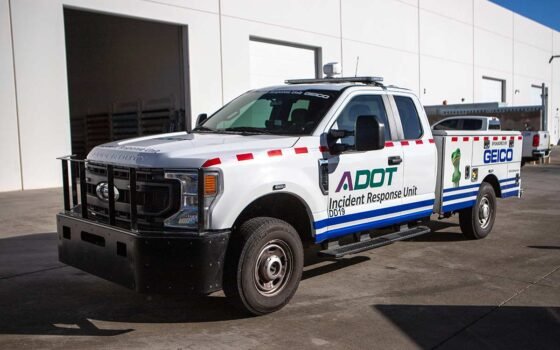Arizona News – Imagine that you’ve been in a car crash involving two vehicles, both of which are no longer driveable and remain in highway travel lanes. Cars are speeding past in other lanes and you need assistance getting your car to the shoulder of the highway.
Across Arizona highways and roads, first responders put their lives on the line every time they respond to vehicle crashes to help motorists. They help those involved in collisions and drivers passing by in other cars, by ensuring their safety after an incident.
During National Crash Responder Safety Week, which runs from Nov. 18-22, the Arizona Department of Transportation (ADOT), Arizona Department of Public Safety (AZDPS), the Arizona Governor’s Office of Highway Safety (GOHS), Arizona Department of Health Services (ADHS), Arizona Professional Towing and Recovery Association (APTRA) and traffic safety stakeholders across Arizona and the nation are calling on the traveling public to be aware: “First responders ahead! Reduce your speed as you proceed!”
“First responders perform lifesaving work to help drivers when a crash occurs, and they need space to work so they can keep themselves and the traveling public safe,” ADOT Director Jennifer Toth said. “Drivers can do their part by always staying alert and slowing down when driving past responders at all incidents.”
When crashes and other incidents occur on the state highway system, ADOT’s Incident Response Unit, sponsored by GEICO, and ADOT crews statewide help get traffic moving safely by setting up traffic control, moving vehicles out of travel lanes and assisting law enforcement and responders at the scene.
“Collision scenes are among the most hazardous areas for State Troopers,” stated Arizona Department of Public Safety Director Colonel Jeffrey Glover. “When you slow down as you approach a scene, you not only assist those involved but also protect the first responders who are there to help.”
There have been at least 283 possible crashes involving first responders or their vehicles on Arizona roads and highways between 2020-2023, according to crash reports compiled by ADOT.
“Don’t be part of the accident scene, move over and give emergency crews (police, fire, ambulance and tow trucks) room to clear the roadway safely and efficiently. Accident scenes are chaotic for first responders, they need to focus on the injured not oncoming traffic. Please be part of a safe solution; slow down and move over when driving past an emergency vehicle,” said GOHS Director Jesse Torrez.
In an effort to educate the public and increase safety for responders, drivers will see safety messages on overhead message boards that remind drivers of Arizona’s “Move Over” law.
“Move Over” requires motorists to move over one lane — or slow down if it’s not safe to change lanes — when approaching any vehicle with flashing lights pulled to the side of a road or highway. This includes emergency vehicles and passenger vehicles flashing hazard lights.
“We need the motoring public’s help to abide by the laws that protect us on the road. Our industry suffers a great loss each year to distracted or impaired drivers,” said Angela Roper, executive director of the Arizona Professional Towing & Recovery Association.
Moving over one lane can save a life. On average, one tow truck operator is killed every six days in the U.S., according to national crash data.
In 2023 in Arizona, there were 122,247 vehicle collisions and crash responders placed themselves at risk of being struck-by or injured or killed while rendering assistance. The Arizona Department of Health Services is responsible for certifying Arizona’s Emergency Medical Services (EMS) providers and knows it’s up to the community to ensure their safety while they’re on the job.
“EMS providers put their lives on the line for us, coming into our lives during our most vulnerable and frightening moments. As drivers, it is our duty to do what we can to keep them safe when they are responding to crashes on our streets and freeways. We must remain aware of our surroundings and ensure our actions behind the wheel contribute to the safety of those working to protect us,” said ADHS Director Jennie Cunico.
Drivers can also protect responders by practicing “quick clearance,” which is a law in Arizona. “Quick clearance” calls for a driver involved in a minor crash without injuries to remove their vehicle from the roadway if it is operable and can be moved safely. “Quick Clearance” improves safety for these groups of people (Spoiler: it’s everyone):
- Drivers and passengers involved in the non-injury collision can inspect their vehicles and exchange insurance information from the shoulder of a highway instead of dangerous travel lanes as cars whizz past.
- Professionals responding to the incident, like law enforcement and tow truck operators, can do their jobs from the safety of the shoulder, instead of travel lanes.
- With travel lanes open, the chance for a secondary collision involving other motorists is reduced.
If you are involved in a crash:
- Make sure you and your passengers are OK.
- If your vehicle is operable, move to the shoulder, median or exit the highway. Stay out of travel lanes.
- Call 911.
- Stay alert and watch for approaching traffic.
- Do not leave the scene of a crash.






